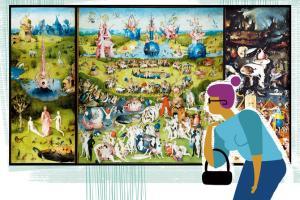Critics are divided on whether the intent of The Garden of Earthly Delights is to warn about the pleasures of the flesh or to celebrate them

Illustration/Ravi Jadhav
 Last week, I found myself standing in an incredibly lucky spot: at Madrid's Prado museum, in front of one of my favourite art works, The Garden of Earthly Delights by the 15th century Dutch painter Hieronymous Bosch. As clouds of Russian, Japanese and French tourists gathered and drifted, I remained transfixed by the boundless artistic energy and detail of the painting.
Last week, I found myself standing in an incredibly lucky spot: at Madrid's Prado museum, in front of one of my favourite art works, The Garden of Earthly Delights by the 15th century Dutch painter Hieronymous Bosch. As clouds of Russian, Japanese and French tourists gathered and drifted, I remained transfixed by the boundless artistic energy and detail of the painting.
ADVERTISEMENT
The painting is in three panels. On the left in sober tones and to-the-point imagery is the creation of Eve. On the right, the Last Judgement, a dark dystopia of bloated musical instruments, tortured humans and terrifying beings. But, it is the justly famous central panel which holds your attention. In a garden with lakes and groves, dozens of figures, human, animal, in-between, run pell mell — you can almost hear them. Like cheerful toy-folk they are running around naked, bearing luscious strawberries, covered in crustacean shells, holding strings of grapes like fairy lights. They are doing all manner of silly, sexy things with each other — planting flowers in a***es, making out in couples and threesomes and many-somes, packing themselves into a human gateau base for a giant strawberry. In the lake, people swim or make love and boats are floated in more senses than one. Each figure is mobile, expressive and urgent. Giggles and laughs spurted out of me several times as I took it in. The painting is astringent yet sweet, "extraordinary/just like a strawberry" as the song goes.
No matter how many times you have seen a great work in reproductions, nothing prepares you for the joy of seeing it in the flesh. Standing before a painting you feel distance between painter and present dissolve and are engulfed by their personal energy and maybe, their intent.
Critics are divided on whether the intent of The Garden of Earthly Delights is to warn about the pleasures of the flesh or to celebrate them. At least for me it felt very hard to see any warning in the central panel, no matter what the Last Judgement entailed. The narrative that excess must one day be paid for may have been present across panels. But, in the work itself, desire and sexual play seemed entirely innocent and joyful, a feeling underscored by the figures being so tiny, they seem like artless children.
Even if the painting were intended as a warning against moral excess, in simply rendering its subject with such artistic excellence, it has ended up conveying the opposite — it makes us celebrate desire, not abjure it. In fact so much of moral storytelling stands out for the way it dwells on the details of the very thing it claims to abhor, as if it must negatively describe what is forbidden, marinate in the description of it, almost to drown out the desire for it. That desire may not be fulfilled for any reason, sometimes even of exclusion from within. I think of someone like the controversial (he has been accused of plagiarism) Indic scholar Rajiv Malhotra, who has heaped such vitriol on liberal scholars and thinkers, finally arriving at the much maligned JNU — after all if JNU is such an abhorrent place as depicted in right-wing fantasies, why even enter this false paradise? But as art shows, the nature of life is perhaps to either rejoice in desire or else be doomed by it.
Paromita Vohra is an award-winning, Mumbai-based film-maker, writer and curator working with fiction and non-fiction. Reach her at www.parodevipictures.com
Catch up on all the latest Crime, National, International and Hatke news here. Also download the new mid- day Android and iOS apps to get latest updates
 Subscribe today by clicking the link and stay updated with the latest news!" Click here!
Subscribe today by clicking the link and stay updated with the latest news!" Click here!







